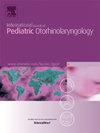Comparison of demographic background and postoperative outcome of unilateral, sequential, and simultaneous cochlear implantation in pediatric patients
IF 1.2
4区 医学
Q3 OTORHINOLARYNGOLOGY
International journal of pediatric otorhinolaryngology
Pub Date : 2025-05-15
DOI:10.1016/j.ijporl.2025.112391
引用次数: 0
Abstract
Objective
This study retrospectively examined cochlear implantation (CI) decisions in children with bilateral hearing loss, comparing unilateral, sequential, and simultaneous implantation approaches.
Methods
The analysis included 102 children aged <6 years who underwent CI. The patients were categorized into unilateral, sequential, and simultaneous groups based on their implantation strategies. Factors influencing the initial CI decision were categorized into audiological, anatomical, and social factors, and the differences among the three groups were analyzed. The change in aided thresholds between the preoperative and postoperative periods was also investigated.
Results
Simultaneous implantations increased over time. A total of 75 % of the patients who received unilateral CI for audiological reasons later underwent CI on the other side. Sequential implantation tended to have worse postoperative thresholds with a hearing aid (HA) compared to preoperative levels with an HA. Only 44 % of patients with unilateral CI could effectively use a contralateral HA, and none of them achieved better speech recognition with an HA in the contralateral ear than in the CI implanted side.
Conclusion
There is little evidence supporting unilateral CI in candidates without anatomical or social limitations, and simultaneous CI is recommended.
儿童患者单侧、序贯和同期人工耳蜗植入术的人口统计学背景和术后结果比较
目的回顾性研究双侧听力损失儿童的人工耳蜗植入术,比较单侧、顺序和同时植入术。方法分析102例接受CI治疗的6岁儿童。根据患者的植入策略将患者分为单侧组、顺序组和同步组。将影响初次CI决策的因素分为听力学、解剖学和社会因素,并分析三组之间的差异。术前和术后辅助阈值的变化也进行了研究。结果同期种植数量随时间增加而增加。由于听力学原因接受单侧CI的患者中,有75%后来在另一侧接受了CI。与术前相比,顺序植入助听器(HA)的术后阈值更差。只有44%的单侧CI患者可以有效地使用对侧HA,并且没有一个患者在对侧耳使用HA比在CI植入侧获得更好的语音识别。结论没有解剖学或社会限制的候选人单侧CI的证据很少,建议同时CI。
本文章由计算机程序翻译,如有差异,请以英文原文为准。
求助全文
约1分钟内获得全文
求助全文
来源期刊
CiteScore
3.20
自引率
6.70%
发文量
276
审稿时长
62 days
期刊介绍:
The purpose of the International Journal of Pediatric Otorhinolaryngology is to concentrate and disseminate information concerning prevention, cure and care of otorhinolaryngological disorders in infants and children due to developmental, degenerative, infectious, neoplastic, traumatic, social, psychiatric and economic causes. The Journal provides a medium for clinical and basic contributions in all of the areas of pediatric otorhinolaryngology. This includes medical and surgical otology, bronchoesophagology, laryngology, rhinology, diseases of the head and neck, and disorders of communication, including voice, speech and language disorders.

 求助内容:
求助内容: 应助结果提醒方式:
应助结果提醒方式:


